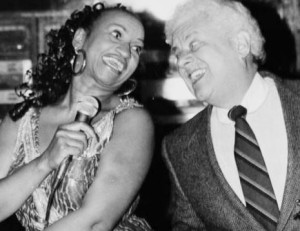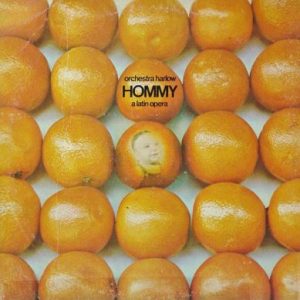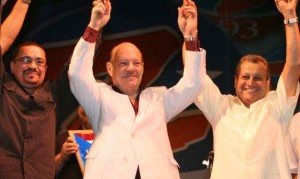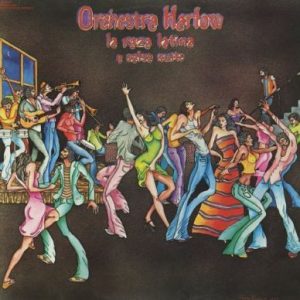It’s been 40 years since Larry Harlow introduced “Hommy, a Latin Opera“, which became a Salsa music classic.
“Hommy” narrates the story of a disabled boy who has a remarkable talent with the drum. It was a project like not other in Salsa music at the time, and even until this day!
Hommy and Salsa Music in 1973 New York
The Salsa music scene in New York 1973 was full of evolution and changes. Larry Harlow had just lost his charismatic lead singer, Ismael Miranda, who started his solo career. Ismael formed his Orquesta Revelacion and released the Salsa music classic album “Asi Se Compone un Son“.
Ray Barretto had also gone through a bit of a mutiny in his band. He saw almost half of it leave, including his lead singer Adalberto Santiago, and Fania All Star timbalero Orestes Vilató to form the Tipica 73.
Unknown to us, Willie Colon and Hector Lavoe were releasing their last albums together. Salsa’s great duo released “Lo Mato” followed by “Asalto Navideño Vol 2“. The latter was perhaps the album that captured the duo at its best!
Larry Harlow had been searching for new musical things. The last album Ismael Miranda recorded with Harlow, was pretty much a warm up for Ismael going solo. It had Ismael featured with Orchestra Harlow and he appeared by himself in the album cover. Ismael’s charisma and popularity where so strong that people thought this would be a devastating blow to Orchestra Harlow.
To start giving you a taste of “Hommy“, here’s the first song of the album, with Justo Betancourt (as Hommy’s father) singing “Es Un Varon“.
A New Concept in Salsa Music
With “Hommy“, Harlow completely avoided comparisons with his previous Salsa music work with Ismael Miranda. He introduced a completely new concept in Salsa music. In doing so, he featured some of Salsa music best stars, and along the way. Additionally, he introduced his new singer to the Salsa music world. After listening to “Hommy” many of us asked, “Ismael who?”
One of the Salsa star singers that performed in “Hommy” was Celia Cruz. Just over a year before the recording, Celia had finished her work with Tito Puente (which spanned 5 albums over 6 years). It’s said that Larry Harlow bumped into a semi-retired Celia Cruz in Mexico, and convinced her to meet with him and Masucci for a possible collaboration with FANIA.

Unknown to Celia, the meeting turned out to be in the recording studio of “Hommy“. There, Harlow convinced her to perform the female role of “Gracia Divina“. Although initially upset by the tactic used to bring her to the recording studio, Celia Cruz agreed, learned the song, and recorded it that day. The story has it that Celia did the song in just one single take.
The song was a hit, and her collaboration with FANIA was established. Later that year (1973) Celia would record with the Fania All Stars her mega hit “Bemba Colorá” as part of the “Fania All Stars Live at Yankee Stadium” albums.
Like many Rock music fans, Harlow must have found The Who’s “Tommy” an amazing concept. Larry must subscribe to the same Picasso school of thought as Steve Jobs, who quoted the Spaniard in saying “good artists borrow, great artists steal”.
Here’s Celia as “Gracia Divina”
“Hommy” Plot and Characters
“Hommy” stole heavily from The Who’s “Tommy“. The British band released the double album in 1969 to great acclaim. Harlow’s “Hommy” is pretty much a great adaptation of the concept and the plot. There are many similarities, starting with the name. Substitute the “T” with an “H” and voila! The plot revolves around a deft-dumb, blind boy who has a great impact on his community due to an inspiring talent despite his disability.

From there, Harlow’s creativity took off. He needed a new singer and found Junior Gonzalez, who was young and new to the Salsa music scene. Junior fitted perfectly into the role of the newborn boy (Hommy). Larry Harlow and Cuban “rumbero” Genaro “Heny” Alvarez brilliantly adapted the plot from “Tommy” to a Latino boy and community.
“Tommy” starts off with the birth of the boy “It’s a Boy“. “Hommy” starts the same way with “Es Un Varon“. In both there is the surprise realization of the boy’s disability, a doctor evaluation of the boy, a Christmas gathering (“Christmas” vs.”Dia de Navidad“), the boy’s reaction to music, and a surprising talent (pinball champion vs. sensational drummer “rumbero”).
There are several characters in the opera, and so, Harlow used some of his Fania All Stars singers to fill the roles. These included Adalberto Santiago (el Doctor), Heny Alvarez (narrator, El Heladero), Cheo Feliciano (El Padrino Tio Jose), Celia Cruz (Gracia Divina), Justo Betancourt (Father), and Pete “El Conde” Rodriguez (Elemento del Bonche).
“Hommy“, A Salsa Music Classic
Salsa music fans loved “Hommy“. Many Salsa music fans didn’t even know about The Who’s famous double-album. Hommy’s success was due to great music, a new concept album, and the great guest singers. The timing of the release was equally important.
Keep in mind that the Salsa music world was still buzzing with the amazing Fania All Stars double-album “Live at the Cheetah” and the subsequent documentary movie of this event “Our Latin Thing“. These two releases catapulted the popularity of Salsa music and it’s principal stars.

When Harlow released “Hommy” in 1973, it was the 1st time since “Live at the Cheetah” that Salsa fans experienced these stars singing in the same album. At the time, the next Fania All Stars release “Live at Yankee Stadium” was just being put together to be recorded. In addition, “Hommy” also had the already popular Celia Cruz and the newly arrived Junior Gonzalez, who did an amazing job in the role of “Hommy“. Salsa fans were hungry to hear something new from their newly minted super-stars. Larry Harlow seized the opportunity!
Here’s Junior Gonzalez in “Quirinbomboro”
Great Performances!
The performances in “Hommy” where memorable. All singers were at the peak of their performing talent. Perhaps the only exception was Junior Gonzalez, who was just getting started. Heny Alvarez in the role of “El Heladero” and story narrator was amazingly natural.
Harlow used his orchestra, which now had Eddie “Guagua” Rivera on bass to make it (with Harlow at piano) one of the best rhythm sections in Salsa music. The percussion section wasn’t far behind, with Tony Jimenez on conga (who did a great job as Hommy the drummer), Eddie Colon on timbales, Pablito Rosario on bongo. Lewis Kahn and Sam Burtis were on trombone, and Ralph Castrella and Larry Spencer (Fania All Stars) were on trumpet.
The coro of Yayo El Indio, Adalberto Santiago, and Marcelino Guerra was among the best you can get at the time. Charlie Rodriguez was the guest in the Cuban “tres” guitar. Lastly, the masterful Angel “Cachete” Maldonado the guest in percussion.
To add to the strong Orchestra Harlow, Larry brought a philharmonic supplement of string and wind sections that gave the music arranged by Harlow and Marty Sheller and majestic flair. In several of the songs, the string section would make my hair stand up. This must be part of the reason why Harlow started using Lewis Kahn on violin in his subsequent recordings starting with the album titled “Salsa”, one of my all-time Salsa music favorite albums.
Most of the album’s songs became huge Salsa hits, including Justo Betancourt’s “Es un Varon“, Heny Alvarez’s “Mantecadito” (a frenzy Guaguanco), and Celia Cruz’s “Gracia Divina“. Adalberto Santiago’s “El Doctor y La Razon“, Junior Gonzalez’s “Soy Sensacional“, and Pete El Conde’s “No Queremos Sermon” were also widely popular.
Hommy’s Impact in the Latino Community
“Hommy” was a successful experiment of what could be done in Salsa music. The fact that no one decided to launch similar projects reflects the hugely ambitious and complicated nature of this project.
Four years later Larry Harlow embarked in another similar themed project when he released “La Raza Latina” in 1977. “La Raza Latina” was more instrumental than sang, but still had some great songs.

Ruben Blades, who participated in “La Raza Latina” project, would conceptualize an original Latino family story into the concept Salsa opera “Maestra Vida” in 1980. Instead of calling it a Salsa opera, Ruben Blades renamed the Salsa musical concept “Focila” to mean “Folclore de Ciudad Latinoamericana“. The double-album was also successful in attracting Salsa fans to its music.
“Hommy” also had an impact in the Latino community. I had a friend in Puerto Rico that had a boy shortly after the release of “Hommy“. He named the boy….yes, you guessed it….”Hommy“. But he wasn’t the only one; if you meet or hear someone named “Hommy” he’s probably just under 40 years old.
Here’s the epic performance of Heny Alvarez in the super Guaguanco “Mantecadito“.
“Hommy” Epilogue
I will conclude this blog by stating that Larry Harlow’s Latin opera “Hommy” was an extremely successful experiment. It came at the right time since Harlow had lost his popular lead singer, people wanted to hear more from their newly minted Salsa idols, and Harlow wanted to do something new.
I still rejoice when I listed to “Hommy“. In addition to the fond memories, I also like it from top to finish as it’s an album filled with great Salsa music. The story moves along quickly and keeps you wanting to follow it until the end.
I invite you to revisit “Hommy” and enjoy it once again, 40 years later!


Henny Alvarez (“Hommy” Latin Opera composer with Larry Harlow) was
from Puerto Rico, not from Cuba.
Julio,
You are absolutely correct. I’ll have to make the correction in the blog.
Gracias!
WONDERING, WAS THERE A MEANING TO THE ORANGES IN THE COVER OF THE ALBUM ?
That’s a great question! I would think there must be a meaning but I have no idea what it might be.
That’s a great question! I don’t know the answer to that one.
[…] father’s perspective on the birth of a son, we go with the opening song of the classic “Hommy” Latin Opera. Justo Betancourt did an impeccable performance in the 1973 Salsa classic. For […]
[…] has played with some of the most recognized names in Salsa and Latin music, including Larry Harlow, Tito Puente, Eddie Palmieri, and Willie Colon among […]
[…] Note: you can find my full blog on the 40th Anniversary of “Hommy” HERE. […]
[…] album was perhaps the best release of Ismael Miranda with Orchestra Harlow. I loved the songs “Yambu Pa’ Gozar“, “Las Mujeres Son“, “Senor […]